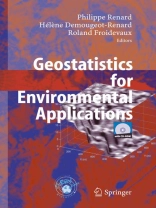Once applied only to problems of mining-reserves assessment or petroleum-reservoir characterization, geostatistics is now being used in an increasingly large number of disciplines in environmental sciences. On the one hand, it enables the analysis and handling, in a rigorous probabilistic framework of the issues of spatial and temporal interpolation of continuous or categorical environmental variables. On the other hand, the methodology is also used to design and optimize sampling campaigns. ‘Geostatistics for Environmental Applications’ contains forty selected contributions covering the latest progress in a broad spectrum of fields including air quality, climatology, ecology, groundwater hydrology, surface hydrology, oceanography, soil contamination, epidemiology and health, natural hazards, and remote sensing.
Table of Content
Change of support: an inter-disciplinary challenge.- Combining categorical and continuous information using Bayesian Maximum Entropy.- Geostatistical prediction of spatial extremes and their extent.- Monitoring network optimisation using support vector machines.- Bayesian Kriging with lognormal data and uncertain variogram parameters.- Kriging of scale-invariant data: optimal parameterization of the autocovariance model.- Scaling Effects on Finite-Domain Fractional Brownian Motion.- The delineation of fishing times and locations for the Shark Bay scallop fishery.- A spatial extension of CART: application to classification of ecological data.- Using a Markov-type model to combine trawl and acoustic data in fish surveys.- Mapping unobserved factors on vine plant mortality.- Analysis and modelling of spatially and temporally varying phenological phases.- Detection of spatial clusters and outliers in cancer rates using geostatistical filters and spatial neutral models.- Geostatistical assessment of long term human exposure to air pollution.- Air quality models resulting from multi-source emissions.- Variogram estimation with noisy data in the space-time domain: application to air quality modelling.- Multiple-point geostatistics: a powerful tool to improve groundwater flow and transport predictions in multi-modal formations.- Simulation of radionuclide mass fluxes in a heterogeneous clay formation locally disturbed by excavation.- Modeling density-dependent flow using hydraulic conductivity distributions obtained by means of non-stationary indicator simulation.- Random field approach to seawater intrusion in heterogeneous coastal aquifers: unconditional simulations and statistical analysis.- Uncertainty estimation of well catchments: semianalytical post-processing.- Conditional moments of residence time of sorbent solutes under radial flow.- Impact of the choice of the variogram model on flow and travel time predictors in radial flows.- Strategies to determine dispersivities in heterogeneous aquifers.- Solving the groundwater inverse problem by successive flux estimation.- Inverse problem for highly heterogeneous porous media: the factorial geostatistical analysis in differential system method.- Inverse stochastic estimation of well capture zones with application to the Lauswiesen site (Tübingen, Germany).- “Soft” geostatistical analysis of radioactive soil contamination.- Modelling the spatial distribution of copper in the soils around a metal smelter in northwestern Switzerland.- Towards a real-time multi-phase sampling strategy optimization.- Spatio-temporal mapping of sea floor sediment pollution in the North Sea.- Merging Landsat TM and SPOT-P images with geostatistical stochastic simulation.- Characterising local spatial variation in land cover using geostatistical functions and the discrete wavelet transform.- Distinguishing features from outliers in automatic Kriging-based filtering of MBES data: a comparative study.- Forecasting volcanic eruptions using geostatistical methods.- Delineation of estuarine management units: Evaluation of an automatic procedure.- Estimating indicators of river quality by geostatistics.- Stochastic simulation of rainfall using a spacetime geostatistical algorithm.- Inferring the lateral subsurface correlation structure from georadar data: Methodological background and experimental evidence.












